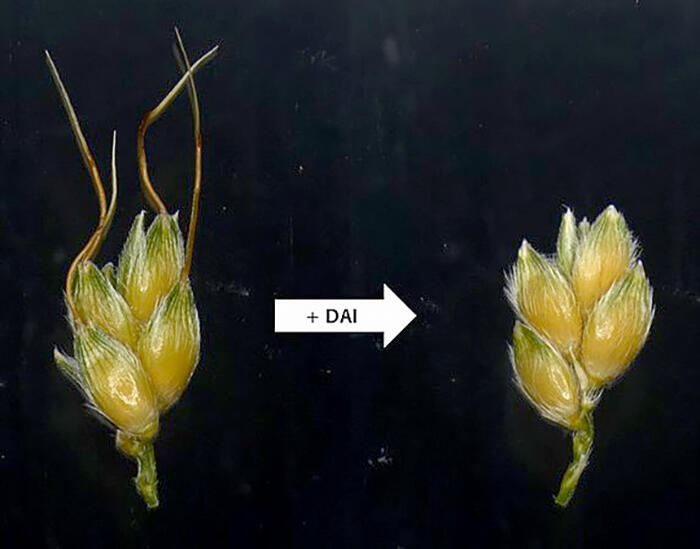A research group consisting of Professor Wataru Sakamoto, Institute of Plant Science and Resources, Okayama University, Research Associate Hideki Takanashi and Professor Nobuhiro Tsustumi, Graduate School of Agricultural and Life Sciences, the University of Tokyo, and their colleagues, has clarified the gene that ensures that awns, structures that protrude from the lemma, do not form on sorghum (a biomass crop).

Provided by Okayama University
When crops and weeds of the grass family form spikelets, a long, thin, protruding structure known as an awn is created at the tip. In wheat fields before harvesting, the awns on the tips of wheat are beautiful as they sway in the wind. Their role is to repel invaders such as birds and wild animals and disperse seeds. However, when it comes to crops, they hinder harvesting and make the crop less tasty as livestock feed, and so are avoided.
In sorghum (a grass crop), the dominant gene that eliminates awns has been known for around 100 years, and has been used for awnless cultivars. On the other hand, 'takakibi', a Japanese landrace sorghum, has many awned cultivars. The research group has carried out genome analysis using a next-generation sequencer known as RAD-seq for 10 years on a hybrid group that used takakibi and American lines.
Their results have identified a dominant gene that eliminates awns, known as "DAI." It has become clear that this gene creates proteins with domains known as ALOG, and that these proteins exhibit awn-specific expression and suppress cell proliferation and elongation. Moreover, the group learned that when DAI is introduced to an awned rice cultivar (Kasalath), the rice awn disappears, so DAI also functions among different cereals. DNA analysis is advancing among grass family plants, particularly plants such as rice and maize. In comparison to these, DAI was found to appear only in sorghum cultivars without awns due to gene duplication. Moreover, it was found that, while there are many awnless cultivars with DAI in lines native to America and the African continent, in Asia there are many awned cultivars without DAI.
Sorghum is a large crop that can grow up to four meters in height, and has attracted attention for its use in biomass as a biomaterial/bioenergy for decarbonization.
Professor Sakamoto commented, "Not only have we clarified the details of a gene that was a mystery for 100 years, we have also used this to develop awnless cultivars, and hope that this will be useful in making grain cultivation more effective and improving its functionality."
■ Gene duplication: A phenomenon in which a DNA region, including certain genes, duplicates within a genome.
Journal Information
Publication: Plant and Cell Physiology
Title: DOMINANT AWN INHIBITOR encodes the ALOG protein originating from gene duplication and inhibits awn elongation by suppressing cell proliferation and elongation in sorghum
DOI: 10.1093/pcp/pcac057
This article has been translated by JST with permission from The Science News Ltd.(https://sci-news.co.jp/). Unauthorized reproduction of the article and photographs is prohibited.




